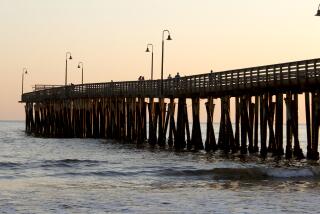Greetings From...
Before the oil and land boom made them unaffordable, before the state’s coastal commission made them unthinkable, tent cities were the summertime hot property on the Southern California sands fringing the Pacific Ocean.
Nowadays, with “tent cities” connoting refugees and the homeless, it is hard to evoke the genteel middle-class tent towns of the teens and ‘20s, with their wooden floors and iron bedsteads, clad in striped canvas under thatched roofs. Tourists who could not afford the grand beach hotels still could summer at the shore.
Tent cities popped up at Catalina, where people could reside in 24-by-30 waterfront tents. The tent city on Seal Beach’s Silver Strand lasted in one form or another from the turn of the century until 1940. In Laguna Beach, a wooden-floored tent that slept four rented for $14 a week. In Venice, at Redondo Beach, on Topanga Beach, tent towns flourished, some even served by streetcars, bathing facilities and stores.
An August 1924 postcard from “Tent City Coronado” reads, “I have put an X where our tent is. We are on the ocean side, so we have a fine breeze all day. We go in for a swim every day and in the evening listen to a good band concert.”
More to Read
Sign up for Essential California
The most important California stories and recommendations in your inbox every morning.
You may occasionally receive promotional content from the Los Angeles Times.











